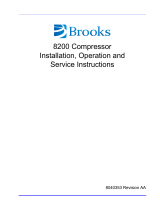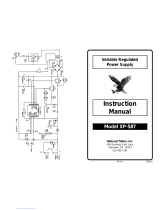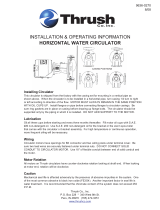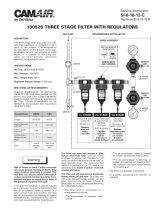
HC-4A and HC-4A2 Zephyr®
Air-Cooled Helium Compressors
Technical Manual
Sumitomo (SHI) Cryogenics of America, Inc.
1833 Vultee Street
Allentown, PA 18103-4783
U.S.A.
Revision C: May 2014 267825A


TABLE OF CONTENTS
i
Page
SAFETY......................................................................................................................... .1
SERVICE ....................................................................................................................... 5
INTRODUCTION .......................................................................................................... 7
Helium Compressor, Models HC-4A and HC-4A2 Zephyr® .................................. 7
PRINCIPLES OF OPERATION .................................................................................... 9
DESCRIPTION ........................................................................................................... 11
Components .................................................................................................... 11
SPECIFICATIONS ...................................................................................................... 17
Electrical Characteristics ................................................................................. 17
Refrigerant Quality ........................................................................................... 18
Helium Gas Pressures ..................................................................................... 18
Compressor Lubricant ..................................................................................... 19
Coolant ............................................................................................................ 19
Compressor Weight ......................................................................................... 19
Compressor Dimensions ................................................................................... 19
Space Requirements ......................................................................................... 19
Room Heating ................................................................................................... 19
Mounting Position ............................................................................................ 19
Environmental Requirements .......................................................................... 19
Protective Earth Terminal ................................................................................ 19
Maintenance Intervals ....................................................................................... 19
Installation Adapter Fitting ................................................................................ 19
Adapter Fittings (Optional Accessory)............................................................... 19
Remote On/Off Cable (Optional Accessory) ...................................................... 20
Supplier Name and Address ............................................................................ 20
Regulatory Compliance ................................................................................... 20
INSTALLATION .......................................................................................................... 21
Introduction ....................................................................................................... 21
Receipt Inspection Instructions ........................................................................ 21
Compressor Position ........................................................................................ 23
Mains Power Supply Connection ..................................................................... 23
Field Wire the Compressor .............................................................................. 25
Compressor Checkout ..................................................................................... 26
Interconnections .............................................................................................. 26
Remote On/Off Cable (Optional Accessory) .................................................... 28
Compressor Shipping Preparation ..................................................................... 28
OPERATION ............................................................................................................. 31
Prestart Check ................................................................................................. 31
Starting ............................................................................................................ 31
Stopping .......................................................................................................... 31
Restarting after a Power Failure ...................................................................... 31

TABLE OF CONTENTS
(continued)
ii
Page
MAINTENANCE ......................................................................................................... 33
Air Filter Cleaning or Replacement .................................................................. 34
Adsorber Replacement .................................................................................... 34
Adsorber Removal ..................................................................................... 34
Adsorber Installation .................................................................................. 35
Used Adsorber Venting and Disposal ........................................................ 36
Helium Charging and Venting .......................................................................... 36
Helium Charging Procedure ........................................................................ 36
Helium Venting Procedure to Adjust the Equalization Pressure ................. 37
Helium Venting Procedure to Vent to Atmospheric Pressure ..................... 38
Gas Cleanup ................................................................................................... 38
Helium Leak Check .......................................................................................... 40
Helium Leak Repair ......................................................................................... 40
Coolant System Leak Repair ............................................................................. 41
Replace the Compressor Shell High Temperature Switch ................................. 42
Replace Fuses .................................................................................................. 43
TROUBLESHOOTING ................................................................................................ 45
Automatic Shutdown ........................................................................................ 45
Troubleshooting Guide .................................................................................... 46
Compressor Capsule ....................................................................................... 49
Winding Continuity, Grounding and Resistance Checks ............................. 49
Current Measurement ................................................................................ 50
Fan and Circulator ........................................................................................... 51
Winding Continuity, Grounding and Resistance Checks – Fan and
Circulator Motors ........................................................................................ 51
PARTS ....... ............................................................................................................... 59
Ordering .......................................................................................................... 59
Compressor Parts Identification and Numbers ................................................. 59
Adapter Fittings ............................................................................................... 65
Cables ............................................................................................................. 66
ILLUSTRATIONS LIST
Figure 1 HC-4A Zephyr® Series Flow Diagram .............................................. 9
Figure 2 HC-4A Zephyr® Outline Dimensions and Parts Identification .......... 13
Figure 3 HC-4A2 Zephyr® Outline Dimensions and Parts Identification ........ 14
Figure 4 Connections for Mains Power Supply ............................................ 25
Figure 5 Connect Gas Line to Compressor or Manifold ................................ 27
Figure 6 Compressor Shell High Temperature Switch ................................... 43
Figure 7 Compressor Terminals ................................................................... 50
Figure 8 HC-4A Wiring Diagram (Main Electrical Chassis and
Components) ................................................................................ 53
Figure 9 HC-4A2 Wiring Diagram (Main Electrical Chassis and
Components) ................................................................................ 54
Figure 10 HC-4A and HC-4A2 Wiring Diagram (Air-Cooled Unit) ................... 55
Figure 11 HC-4A Electrical Schematic ........................................................... 56

iii
Page
ILLUSTRATIONS LIST (continued)
Figure 12 HC-4A2 Electrical Schematic (Main Electrical Chassis and
Components) ................................................................................ 57
Figure 13 HC-4A2 Electrical Schematic (Air-Cooled Unit) .............................. 58
Figure 14 Parts Identification .......................................................................... 61
Figure 15 Parts Identification for HC-4A ......................................................... 62
Figure 16 Parts Identification for HC-4A2 ........................................................ 63
Figure 17 Parts Identification .......................................................................... 64
Figure 18 Adapter Fitting, 8F and 8M, with Valve ........................................... 65
Figure 19 Adapter Fitting, 8F, with Valve ......................................................... 65
TABLES
Table 1 Terminal Position for Mains Power Supply .......................................... 24
SJM P/N 267825A

iv
(This page is intentionally blank.)

SAFETY
1
GENERAL
The HC-4A Zephyr® Series Air-Cooled Helium Compressor is designed to operate safely when
the installation, operation and servicing are performed in accordance with the instructions in this
technical manual. Consult the nearest SCAI Service Center with any questions you may have
concerning the use or maintenance of these compressors. For Service Center locations, see
the Service section of this manual.
SPECIAL NOTICES
Three types of special notices - WARNINGS, CAUTIONS and NOTES are used in this technical
manual. They appear as follows and serve the purposes stated.
WARNINGS call attention to actions or conditions that can result in serious injury or death to
personnel.
CAUTIONS call attention to actions or conditions that can result in damage to the equipment or
in abnormal performance.
NOTE
NOTES give important, additional information, explanations or recommendations related to the
procedure or discussion presented.
WARNINGS and CAUTIONS, like other safety instructions, appear within rectangles in the text
where they are especially applicable. Because of their importance, they are summarized in this
section and in the General Technical Manual, and should be read first.

Safety
2
WARNINGS
AVOID ELECTRIC SHOCK. All electrical supply equipment must meet applicable codes and
be installed by qualified personnel. Permit only qualified electrical technicians to open electrical
enclosures, to perform electrical checks or to perform tests with the power supply connected
and wiring exposed. Failure to observe this warning can result in serious injury or death.
Disconnect the power to the compressor before troubleshooting the electrical components or
replacing fuses.
AVOID INJURY. Never use compressed helium gas from a cylinder without a proper regulator.
Overpressure can cause serious injury if the system equipment ruptures.
During operation, some surfaces under the compressor’s cover become hot. Allow the
compressor to cool for 1/2 hour after shutdown before removing the cover for maintenance.
Always wear eye protection when handling pressurized gas lines and other pressurized
equipment. Never apply heat to a pressurized gas line or other pressurized components.
Disconnect gas lines only when the compressor is stopped. Disconnecting the cold head while
it is cold can create excessively high internal pressure as the gas warms. Material failure and
uncontrolled pressure release can cause injury.
Use two wrenches when disconnecting a gas line coupling to avoid loosening the cold head or
compressor coupling. Gas pressure can project the coupling with enough force to cause
serious injury.
The compressor is charged with helium gas. Vent both supply and return Aeroquip couplings to
atmospheric pressure before disassembly, except when disconnecting the adsorber or the gas
lines. Uncontrolled pressure release can cause serious injury.
Always vent a gas-charged component before beginning to disassemble its couplings. Gas
pressure can launch a loose coupling with enough force to cause serious injury.
The adsorber is charged with helium gas. Follow the used adsorber venting procedure for safe
disposal of the used adsorber.
Rotating fan blade can cause injury. Disconnect power before removing compressor covers for
maintenance.
Coolant fluid is a 30% ethylene glycol/water mixture. TOXIC: Do not ingest. Contact local
environmental authorities for proper disposal of ethylene glycol mixtures.
CAUTIONS
PRESERVE YOUR WARRANTY. Modification to equipment without the consent of the
manufacturer will void the warranty.
Specifications require the use of 99.995% pure helium gas. Using a lesser quality of helium can
damage the system and void the warranty.

Safety
3
CAUTIONS (continued)
AVOID GAS LEAKS. Check the condition of the gasket face seal on the male half of each
Aeroquip coupling. Be sure the gasket face seal is in place and the sealing surfaces on both
the male and female halves are clean before connecting. Replace the gasket face seal if it is
damaged or missing.
Keep the gas line couplings aligned when making or breaking a coupling connection. Leaks can
occur due to the weight of the gas line or due to a sharp bend near the connection.
AVOID CONTAMINATION. When checking the compressor for shipping damage, do not
connect gas lines and cold head. The components may become contaminated with
compressor oil.
Follow the charging or venting procedures to prevent reversed flow of system gas. Do not
charge through the supply coupling. Do not vent through the return coupling. Reversed flow
can contaminate the system with compressor oil.
A leaking coupling on an adsorber should not be repaired in the field. Consult a Service Center.
Venting the adsorber will introduce contaminants to the system, which cannot be removed in the
field.
PREVENT EQUIPMENT DAMAGE. Damage to gas lines can result from crimping by repeated
bending and repositioning.
Never pull a vacuum on the compressor or on the cold head. The motors will short circuit if
started.
AVOID A MALFUNCTION. Repeatedly charging the system with helium gas rather than
locating and repairing gas leaks can cause a malfunction. Impurities are introduced at an
abnormal rate and can freeze in the cold head.
Do not allow air to get into the helium gas refrigerant of the system. Moisture from the
atmosphere can seriously degrade cold head performance.
AVOID EQUIPMENT FAILURE, CONTAMINATION OR A NUISANCE SHUTDOWN. Do not
tip the compressor greater than 5 degrees from horizontal, to avoid flowing oil into unwanted
places.

4
(This page is intentionally blank.)

SERVICE
5
HEADQUARTERS
Sumitomo (SHI) Cryogenics of America, Inc.
1833 Vultee Street
Allentown, PA 18103-4783
Sales and Parts
TEL: (800) 525-3072
or
(610) 791-6700
FAX: (610) 791-0440
Service
TEL: (800) 525-3071
or
TEL: (610) 791-6750
SERVICE CENTERS
Eastern
U.S.A
Sumitomo (SHI) Cryogenics of America, Inc.
1833 Vultee Street
Allentown, PA 18103-4783
TEL: (800) 525-3071
or
(610) 791-6750
FAX: (610) 791-3904
Western
U.S.A.
Sumitomo (SHI) Cryogenics of America, Inc.
1800 Wyatt Dr.
Suite 13
Santa Clara, CA 95054
TEL: (408) 736-4406/4407
FAX: (408) 736-7325
Europe
Sumitomo (SHI) Cryogenics of Europe, Ltd.
3 Hamilton Close
Houndmills Industrial Estate
Basingstoke
Hampshire RG21 6YT
United Kingdom
TEL: +44 1256 853333
FAX: +44 1256 471507
Sumitomo (SHI) Cryogenics of Europe, GmbH
Daimlerweg 5a
D-64293 Darmstadt
Germany
TEL: +49 6151 860 610
FAX: +49 6151 800 252
Asia
Sumitomo Heavy Industries, Ltd.
Service Section
Cryogenics Division
2-1-1 Yato-Cho Nishitokyo-City
Tokyo 188-8585
Japan
TEL: +81 424 68 4265
FAX: +81 424 68 4462
Sumitomo (SHI) Cryogenics Korea, Co., Ltd.
Room 619-620, Venture Valley
#958 Goseck-Dong, Kwonsun-Gu
Suwon-City, Gyeonggi-Do
South Korea
TEL: +82 31 278 3050
FAX: +82 31 278 3053
Sumitomo Heavy Industries (Shanghai)
Management, Ltd.
Room 107-110, Building 5
No. 100, Zixiu Road
Shanghai 201103
People’s Republic of China
TEL: +86 21-6070-5200
FAX: +86 21-6070-5086
Sumitomo (SHI) Cryogenics Taiwan Co., Ltd.
4th Floor, No.3
Lane 216, Gongyuan Rd.
Hsinchu City 300
Taiwan ROC
Phone: +886 3 561 2557/2101
Fax: +886 3 562 3400

6
(This page is intentionally blank.)

INTRODUCTION
7
Helium Compressor Models HC-4A and HC-4A2 Zephyr®
The compressors are single-stage, air-cooled, rotary, designed to deliver high-pressure, oil-free
helium gas to cryogenic refrigerators. Cold head cables are used to supply electrical power to
cryogenic cold heads. Self-sealing couplings allow for easy connection to and disconnection
from the rest of the closed-cycle cryogenic refrigeration system.
The information in this manual pertains only to the HC-4A Zephyr® Series Compressors. Other
components used to form an operating system are described in separate technical manuals.
Pressures are stated as gauge, not absolute. Psig is pounds per square inch gauge and kPa is
Kilopascals gauge,
kPa = 6.895 x Psig.
Definition of Symbols used in this manual and on equipment:
Power Switch On
Protective Earth (Ground) Terminal
O Power Switch Off
WARNING Risk of Electric Shock
CAUTION Refer to Manual V ~
Volts, AC, 1 Phase
WARNING Cutting of Fingers or
Hand

8
(This page is intentionally blank.)

PRINCIPLES OF OPERATION
9
The compressor continuously draws low-pressure helium from the system return line.
It compresses, cools and cleans the gas, then delivers it through the system gas supply line
to the cold head. See Figure 1.
1.
Oil Injection Filter
12.
Gas Equalization Solenoid Valve
2.
Oil Injection Orifice
13.
Gas Supply Coupling
3.
Heat Exchanger
14.
Gas Return Coupling
4.
Compressor Capsule
15.
Temperature Switches (oil, gas
and compressor shell)
5.
Oil Separator
16.
Internal Relief Valve
6.
Oil Capillary Filter
17.
Helium Pressure Relief Valve
7.
Oil Capillary
18.
Coolant Pressure Relief Valve
8.
Adsorber
19.
Circulator
9.
Internal By-pass Orifice
20.
Accumulator
10.
Surge Bottle
21.
Air Heat Exchanger
11.
Gas Supply Pressure Gauge
22.
Fan
Figure 1 HC-4A Zephyr® Series Flow Diagram

Principles of Operation
10
When gas leaves the compressor, the gas contains heat and compressor lubricant. Both must
be removed. From the compressor, the hot gas with its entrained oil flows over the motor
winding, where the gas loses some of its suspended oil, then out of the shell and through one
circuit of a three-circuit heat exchanger, where it is cooled by circulating coolant (water/30%
ethylene glycol). Next, the gas passes through the oil separator and the adsorber for oil and
moisture removal. From the adsorber, the high-pressure gas is supplied to the cold head
through gas lines.
Through the system gas return line, low-pressure gas from the cold head flows into the
compressor.
A gas line containing an internal by-pass solenoid valve connects the high-pressure line to the
low-pressure line. The by-pass valve will open to prevent overloading the motor when the
system gas lines are not connected to the compressor.
Oil is separated from the gas in three stages. The first stage is by precipitation when the gas
passes over the motor windings. The second stage is in the oil separator whose element
collects oil mist from the gas; oil is agglomerated and returned to the compressor. The third
stage is the adsorber that removes any remaining oil the gas is carrying.
Oil collected in the separator flows back to the compressor through a capillary tube. The
differential gas pressure across the system is the moving force, and the capillary size limits
the amount of gas bypassed. The small amount of oil collected in the adsorber remains there
and is removed only by replacing the adsorber.
Oil in the compressor capsule also collects heat. The shell-wrapped heat exchanger removes
heat from the compressor motor and from the warm oil by direct conduction through the
compressor shell. Gas pressure pushes oil through the heat exchanger’s outer tubes that cool
the warm oil from the compressor. This cooled oil is then reinjected into the gas return line,
which returns the oil to the compressor to reabsorb heat and lubricate the compressor.
The circulating coolant is cooled by room air moved by a fan through an air heat exchanger and
out the top of the compressor unit.
The coolant system is sealed and requires no regular maintenance.

DESCRIPTION
11
The components of the HC-4A Zephyr® Series Air-Cooled Compressor are identified
schematically in Figure 1. Figure 2 identifies front panel components. Features and functions
of individual components are described in the following paragraphs.
Components (See Figures 1, 2 and 3)
50/60 Hz Toggle Switch (HC-4A2 only): This switch is used to select different phasing circuits
for cold head operation at 50 Hz or 60 Hz.
Accessory Receptacle and Optional Remote On/Off Cable: The accessory receptacle
mounted on the front panel is a 14-socket connector for supplying remote on/off capability. The
remote on/off cable is available as an option.
Circuit Breaker: A panel-mounted, 20 ampere, circuit breaker in the main power supply
protects the compressor from electrical overload.
Cold Head Receptacle and Optional Cables: A 28-socket receptacle mounted on the front
panel and a cold head cable supply electrical power from the compressor to the cold head. The
HC-4A compressor can be supplied with cold head cables for operating a DE-202, DE-204SL,
M204S or CH204S Cold Head. The HC-4A2 compressor can be supplied with a cold head
cable for operating an RDK-101 series cold head.
Compressor Power Cord: Terminating with a 3-prong, NEMA L6-20P plug, the power cord
supplies electrical power to the compressor.
Elapsed Time Meter: The battery-operated LCD digital display, elapsed time meter shows the
compressor’s cumulative running time in hours up to a total of 99,999 hours.
AVOID INJURY. The compressor’s elapsed time meter contains a lithium
battery. Do not remove the battery. Do not recharge, disassemble, mutilate, wet
or dispose of the meter in fire. Contact local environmental authorities for proper
disposal of the lithium battery.
Electrical Chassis: The electrical chassis contains electrical components and connections and
distributes power to all system circuits. The wire terminals are accessible by removing a cover
from the front panel of the compressor. Components are accessible by removing the right side
cover from the compressor capsule.

Description
12
Fuses:
Fuse
HC
-
4A
HC
-
4A2
Ci
rcuit
Location
FU1 0.63 AT 1.0 AT Cold Head Front Panel
FU2 0.63 AT 1.0 AT Cold Head Front Panel
FU3 5.0 AT 5.0 AT Cold Head Front Panel
FU4 5.0 AT 5.0 AT Cold Head Front Panel
FU5 0.4 AT 0.4 AT Control Inside Electrical Chassis
FU6 0.4 AT 0.4 AT Control Inside Electrical Chassis
FU7 1.0 AT 1.0 AT Fan and Circulator Inside Fan Cabinet
FU8 1.0 AT 1.0 AT Fan and Circulator Inside Fan Cabinet
FU9 0.63 AT 0.63 AT Fan and Circulator Inside Fan Cabinet
Gas Supply and Return Couplings: Both are self-sealing, size 8, male, Aeroquip, bulkhead
couplings and are the points of connection on the front panel for the rest of the system.
Power On/Off Switch: This on/off rocker switch starts and stops the compressor. The switch
lights to indicate that power is on to the compressor.
Pressure Gauge: A pressure gauge indicates gas pressure in the supply line. When the
compressor is not running, the gauge shows the equalization pressure.

Description
13
Figure 2 HC-4A Zephyr® Outline Dimensions and Parts Identification
(Dimensions in mm)
NOTE
Three (3) 8 mm holes at the bottom of the front panel may be used for bolts to
prevent movement of the compressor.

Description
14
Figure 3 HC-4A2 Zephyr® Outline Dimensions and Parts Identification
(Dimensions in mm)
NOTE
Three (3) 8 mm holes at the bottom of the front panel may be used for bolts to
prevent movement of the compressor.
Page is loading ...
Page is loading ...
Page is loading ...
Page is loading ...
Page is loading ...
Page is loading ...
Page is loading ...
Page is loading ...
Page is loading ...
Page is loading ...
Page is loading ...
Page is loading ...
Page is loading ...
Page is loading ...
Page is loading ...
Page is loading ...
Page is loading ...
Page is loading ...
Page is loading ...
Page is loading ...
Page is loading ...
Page is loading ...
Page is loading ...
Page is loading ...
Page is loading ...
Page is loading ...
Page is loading ...
Page is loading ...
Page is loading ...
Page is loading ...
Page is loading ...
Page is loading ...
Page is loading ...
Page is loading ...
Page is loading ...
Page is loading ...
Page is loading ...
Page is loading ...
Page is loading ...
Page is loading ...
Page is loading ...
Page is loading ...
Page is loading ...
Page is loading ...
Page is loading ...
Page is loading ...
Page is loading ...
Page is loading ...
Page is loading ...
Page is loading ...
Page is loading ...
Page is loading ...
-
 1
1
-
 2
2
-
 3
3
-
 4
4
-
 5
5
-
 6
6
-
 7
7
-
 8
8
-
 9
9
-
 10
10
-
 11
11
-
 12
12
-
 13
13
-
 14
14
-
 15
15
-
 16
16
-
 17
17
-
 18
18
-
 19
19
-
 20
20
-
 21
21
-
 22
22
-
 23
23
-
 24
24
-
 25
25
-
 26
26
-
 27
27
-
 28
28
-
 29
29
-
 30
30
-
 31
31
-
 32
32
-
 33
33
-
 34
34
-
 35
35
-
 36
36
-
 37
37
-
 38
38
-
 39
39
-
 40
40
-
 41
41
-
 42
42
-
 43
43
-
 44
44
-
 45
45
-
 46
46
-
 47
47
-
 48
48
-
 49
49
-
 50
50
-
 51
51
-
 52
52
-
 53
53
-
 54
54
-
 55
55
-
 56
56
-
 57
57
-
 58
58
-
 59
59
-
 60
60
-
 61
61
-
 62
62
-
 63
63
-
 64
64
-
 65
65
-
 66
66
-
 67
67
-
 68
68
-
 69
69
-
 70
70
-
 71
71
-
 72
72
Sumitomo HC-4E1 Technical Manual
- Type
- Technical Manual
- This manual is also suitable for
Ask a question and I''ll find the answer in the document
Finding information in a document is now easier with AI
Other documents
-
Swagelok RHPS Series Regulators User manual
-
 Olicom Compressor 9600 User manual
Olicom Compressor 9600 User manual
-
 Brooks 8200 Installation & Operation Manual
Brooks 8200 Installation & Operation Manual
-
Brooks 8600 Quick Installation Manual
-
 National Tattoo XP-587 User manual
National Tattoo XP-587 User manual
-
 Thrush 1413-1030-3/4 Operating & Maintenance Manual
Thrush 1413-1030-3/4 Operating & Maintenance Manual
-
Meaco MeacoFan 260c Cordless Air Circulator User manual
-
AirSep Onyx User manual
-
Parker NitroFlow HP User manual
-
 DeVilbiss 130526 Service Instruction
DeVilbiss 130526 Service Instruction












































































